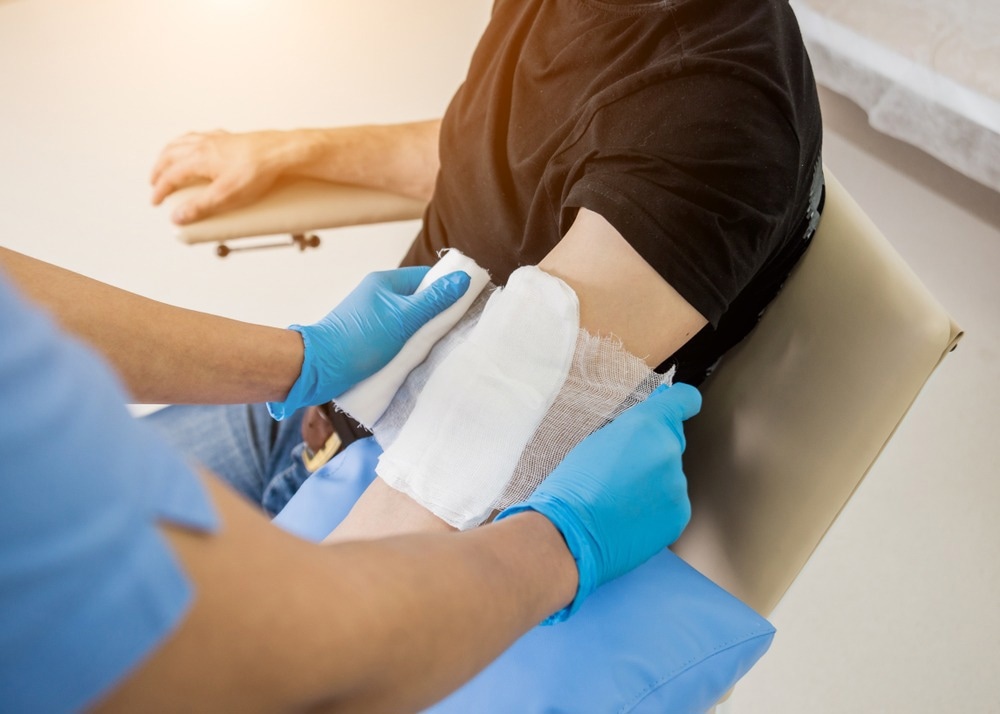Natural tissue recapitulating biomaterials provide a suitable microenvironment to direct cell behaviors and fates. Moreover, natural skin mimicking asymmetric dressing is an efficient approach to enhance wound healing, especially in the case of severe burns.

Study: Biomimetic Asymmetric Composite Dressing by Electrospinning with Aligned Nanofibrous and Micropatterned Structures for Severe Burn Wound Healing. Image Credit: Roman Zaiets/Shutterstock.com
In an article recently published in the journal ACS Applied Materials and Interfaces, an asymmetric composite dressing was fabricated by preparing asymmetric surfaces and modifying the sponge on either side for wettability via electrospinning.
The sponge composed of collagen and quaternized chitosan (Col/ QCS) was fabricated via freeze-drying, wherein the modification of the inner layer with poly(ε-caprolactone) (PCL)/gelatin (Gel) nanofiber-imparted hydrophilicity. On the other hand, by modifying the sponge’s outer layers with micronanostructure, the PCL/polystyrene microsphere imparted hydrophobicity on each side.
The morphology and properties of fabricated asymmetric composite dressing synergistically contributed to the antibacterial activity promoting wound healing in severe burns by managing the cellular behavior. The experimental results obtained from in vitro studies revealed that the nanofiber-aligned inner layer of the sponge promoted all stages from cell adhesion to their proliferation. The outer layer showed resistance to bacterial adhesion and exhibited good mechanical properties.
On the other hand, the in vivo results showed that the fabricated composite dressing reduced inflammatory response, accelerated angiogenesis, prevented infection and epithelial regeneration, and expedited the healing of severe burns. Therefore, the proposed asymmetric composite dressing was expected to serve as a potential candidate for wound healing in severe burns.
Efficient Dressing for Wound Healing in Severe Burns
According to tissue engineering studies, composition, topography, and surface structure of the biomaterials influence cell behavior and fate. Hence, significant effects on stem cells guided their differentiation, promoting neuroregeneration and bone regrowth.
Although various dressings based on hydrogels, sponges, and membranes with loaded bioactive agents were used for wound healing in severe burns, the efficiency of these dressings was limited to their dressing composition while ignoring the influence of structure and topography. Different novel dressings with wettability were prepared by bioprinting, electrostatic spinning, and phase conversion (dry/wet).
In asymmetric wound dressings, a hydrophobic outer layer mimics an epidermal layer in terms of strain resistance, preventing excessive dehydration, resisting bacterial adhesion, maintaining infiltration, and creating a wetting environment. On the other hand, the hydrophilic inner layer can mimic the dermis and allow gas exchange, providing space for cell growth, proliferation, and migration. However, constructing an antibacterial hydrophobic outer layer in composite dressing for severe burns is challenging.
The natural superhydrophobic surface structure in lotus leaves has inspired the development of various micronanostructures. These micronanostructures mimicked the natural superhydrophobic surfaces and had an enhanced superficial roughness that reduced their water contact to improve the material’s hydrophobicity. Thus, preparing the asymmetric dressings based on biomimetic hydrophobic principles with an antibacterial outer layer can help achieve an efficient dressing for wound healing in severe burns.
Biomimetic Asymmetric Composite Dressing for Wound Healing in Severe Burns
In the present study, electrospinning technology was used to create a composite dressing for severe burns with asymmetric structures and surface wettability. The composite dressing prevented bacterial infection and expedited wound healing in case of severe burns. To this end, the composite dressing material mimicked the structure and properties of natural skin.
Initially, a Col/ QCS sponge was created by freeze-drying, followed by its alignment with PCL/gelatin-loaded curcumin (Cur) nanofiber to obtain a hydrophilic inner layer. Furthermore, a hierarchical micronanostructure of PCL/PS on the outer layer imparted hydrophobicity on both sides of the sponge.
Among the two layers, the inner hydrophilic layer was anticipated to promote adhesion, growth, and migration of endothelial cells and fibroblasts via topographic guidance, to achieve a radical scavenging capacity and shortened inflammatory phase due to the controlled release of cur, to heal severe burns.
Moreover, the porous structure of the Col/QCS sponge prevented the accumulation of any exudates, excess dehydration of water from severe burns, and showed antibacterial activity. The lotus leaf superhydrophobic structure mimicking PCL/PS outer layer provided good mechanical support and prevented bacterial adhesion and colonization in severe burns.
Thus, the fabricated asymmetric composite dressing mimicked the dermis and epidermis of the natural skin structurally and exhibited good physical properties, osmotic fluid absorption, biocompatibility, antibacterial ability, and scavenging of reactive oxygen species (ROS). Additionally, reepithelialization, healing rate, angiogenesis, collagen deposition, and anti-inflammatory effects were investigated for asymmetric composite dressing used for wound healing in severe burns.
Conclusion
A composite dressing that mimicked the natural skin was developed with wettability and asymmetric structure to facilitate wound healing in severe burns. The outer layer had a hierarchical micronanostructure, inspired by the lotus leaf effect, and prevented contamination due to bacterial adhesion.
Moreover, the inner layer aligned with nanofiber mimicked the structure of the dermis, which enhanced the biological process from cell adhesion to macrophage polarization. Moreover, the loaded cur on the inner layer showed antioxidant and antibacterial properties that synergized with the morphological structure, reduced the inflammatory reactions, and expedited wound healing in severe burns.
Reference
He, C., Yu, B., Lv, Y., Huang, Y., Guo, J., Li, L., Chen, M et al. (2022). Biomimetic Asymmetric Composite Dressing by Electrospinning with Aligned Nanofibrous and Micropatterned Structures for Severe Burn Wound Healing. ACS Applied Materials & Interfaces. https://pubs.acs.org/doi/10.1021/acsami.2c04323
Disclaimer: The views expressed here are those of the author expressed in their private capacity and do not necessarily represent the views of AZoM.com Limited T/A AZoNetwork the owner and operator of this website. This disclaimer forms part of the Terms and conditions of use of this website.